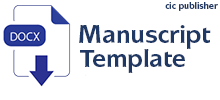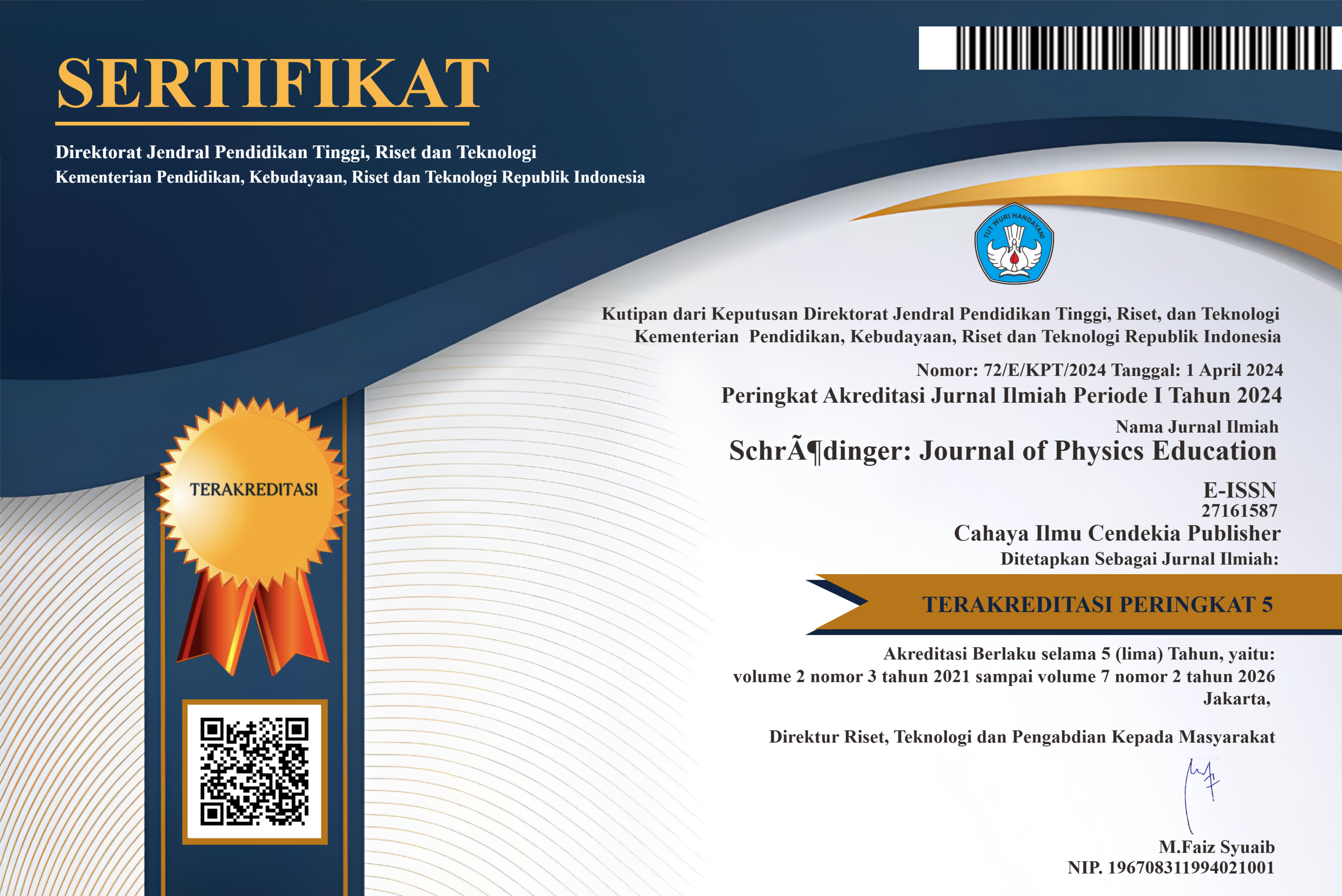Increasing Activity and Science Learning Outcomes Vibrations, Waves and Sound Matter Through STAD Model
Abstract
Purpose of the study: In this research aims to determine increasing activity and science learning outcomes vibrations, waves and sound matter through student teams-achievment divisions (STAD) model.
Methodology: This research is Classroom Action Research implemented in three cycles, each cycle consisting of four stages namely planning, observation, observation and reflection. The subject of this research are students of class VIII B of Pabelan 2 Public Middle School consisting of 32 students of 16 male students and 16 female students. Research instruments include observation guide sheet, questions and documentation guidelines.
Main Findings: The results of the research show that the student teams achievement divisions (STAD) learning model can increase the activity and learning outcomes of Class VIII B students at State Middle Schools as evidenced by the increase in student learning completeness in Cycle I, 37.5% of students have completed learning, in Cycle II, 81% of students have completed learning and Cycle III 99% of students completed their studies.
Novelty/Originality of this study: This research contributes to research with a new foundation in understanding scientific concepts through an innovative approach using the student teams-achievement divisions (STAD) model. The unique findings highlight STAD's significant contribution in stimulating student engagement and increasing achievement of learning outcomes, bringing new nuances to science education research.
References
S. Astuti, I. W. Subagia, and I. K. Sudiana, “Student’ satisfaction toward chemistry learning process at SMA laboratorium undiksha,” J. Pendidik. Indones., vol. 6, no. 2, pp. 233–241, 2018, doi: 10.23887/jpi-undiksha.v6i2.11880.
M. M. Chusni, S. Saputro, S. Surant, and S. B. Rahardjo, “Enhancing Critical Thinking Skills of Junior High School Students through Discovery-Based Multiple Representations Learning Model,” Int. J. Instr., vol. 15, no. 1, pp. 927–945, 2022, doi: 10.29333/iji.2022.15153a.
E. Andriana, A. Syachruroji, T. P. Alamsyah, and F. Sumirat, “Natural science Big Book with Baduy local wisdom base media development for elementary school,” J. Pendidik. IPA Indones., vol. 6, no. 1, pp. 76–80, 2017, doi: 10.15294/jpii.v6i1.8674.
Z. Y. Kalender, E. Marshman, C. D. Schunn, T. J. Nokes-Malach, and C. Singh, “Damage caused by women’s lower self-efficacy on physics learning,” Phys. Rev. Phys. Educ. Res., vol. 16, no. 1, p. 10118, 2020, doi: 10.1103/PHYSREVPHYSEDUCRES.16.010118.
C. D. Stylinski, K. Peterman, T. Phillips, J. Linhart, and R. Becker-Klein, “Assessing science inquiry skills of citizen science volunteers: a snapshot of the field,” Int. J. Sci. Educ. Part B Commun. Public Engagem., vol. 10, no. 1, pp. 77–92, 2020, doi: 10.1080/21548455.2020.1719288.
G. R. Iyer, M. Blut, S. H. Xiao, and D. Grewal, “Impulse buying : a meta-analytic review,” pp. 384–404, 2020.
N. L. A. Razzak, “Cultural factors impacting student motivation at a health sciences college in the Eastern province of Saudi Arabia,” Cogent Educ., vol. 3, no. 1, pp. 1–21, 2016, doi: 10.1080/2331186X.2016.1153214.
A. Sithole, E. T. Chiyaka, P. McCarthy, D. M. Mupinga, B. K. Bucklein, and J. Kibirige, “Student Attraction, Persistence and Retention in STEM Programs: Successes and Continuing Challenges,” High. Educ. Stud., vol. 7, no. 1, p. 46, 2017, doi: 10.5539/hes.v7n1p46.
P. Lavega, Q. Prat, U. S. De Ocáriz, J. Serna, and V. Muñoz-Arroyave, “Aprendizaje basado en la reflexión sobre la acción a través de los juegos tradicionales. El caso de la pelota sentada,” Cult. y Educ., vol. 30, no. 1, pp. 142–176, 2018, doi: 10.1080/11356405.2017.1421302.
J. Marshel and Ratnawulan, “Analysis of Students Worksheet (LKPD) integrated science with the theme of the motion in life using integrated connected type 21st century learning,” J. Phys. Conf. Ser., vol. 1481, no. 1, 2020, doi: 10.1088/1742-6596/1481/1/012046.
S. Zubaidah, N. M. Fuad, S. Mahanal, and E. Suarsini, “Improving creative thinking skills of students through Differentiated Science Inquiry integrated with mind map,” J. Turkish Sci. Educ., vol. 14, no. 4, pp. 77–91, 2017, doi: 10.12973/tused.10214a.
E. F. S. Rini and F. T. Aldila, “Practicum Activity: Analysis of Science Process Skills and Students’ Critical Thinking Skills,” Integr. Sci. Educ. J., vol. 4, no. 2, pp. 54–61, 2023, doi: 10.37251/isej.v4i2.322.
M. Classens and E. Sytsma, “Student food literacy, critical food systems pedagogy, and the responsibility of postsecondary institutions,” Can. Food Stud. / La Rev. Can. des études sur l’alimentation, vol. 7, no. 1, pp. 8–19, 2020, doi: 10.15353/cfs-rcea.v7i1.370.
Crisvin, M. Asbari, and J. V. Chiam, “Innovate to Liberate : Akselerasi Kreativitas Siswa dalam Pendidikan,” J. Inf. Syst. Manag., vol. 2, no. 5, pp. 8–12, 2023.
B. C. Madu, “Scientific Explanation of Phenomenon, Imagination and Concept Formation as Correlates of Students’ Understanding of Physics Concepts,” J. Nat. Sci. Res., vol. 11, no. 16, pp. 17–28, 2020, doi: 10.7176/jnsr/11-16-03.
J. P. Zwolak, R. Dou, E. A. Williams, and E. Brewe, “Students’ network integration as a predictor of persistence in introductory physics courses,” Phys. Rev. Phys. Educ. Res., vol. 13, no. 1, pp. 1–14, 2017, doi: 10.1103/PhysRevPhysEducRes.13.010113.
T. R. Tretter, Y. Ardasheva, J. A. Morrison, and A. Karin Roo, “Strengthening science attitudes for newcomer middle school english learners: visually enriched integrated science and language instruction,” Int. J. Sci. Educ., vol. 41, no. 8, pp. 1015–1037, 2019, doi: 10.1080/09500693.2019.1585993.
D. K. Capps, J. T. Shemwell, and A. M. Young, “Over reported and misunderstood? A study of teachers’ reported enactment and knowledge of inquiry-based science teaching,” Int. J. Sci. Educ., vol. 38, no. 6, pp. 934–959, 2016, doi: 10.1080/09500693.2016.1173261.
D. K. Murti, G. Gunarhadi, and W. Winarno, “Development of Educational Comic with Local Wisdom to Foster Morality of Elementary School Students: A Need Analysis,” Int. J. Educ. Methodol., vol. 6, no. 2, pp. 337–343, 2020, doi: 10.12973/ijem.6.2.337.
D. Hendriyani, “E-Module Based Guided Inquiry: Business And Energy For Senior High Schools,” Schrödinger J. Phys. Educ., vol. 4, no. 2, pp. 47–52, 2023, doi: 10.37251/sjpe.v4i2.505.
O. Sengul, P. J. Enderle, and R. S. Schwartz, “Examining science teachers’ enactment of argument-driven inquiry (ADI) instructional model,” Int. J. Sci. Educ., vol. 43, no. 8, pp. 1273–1291, 2021, doi: 10.1080/09500693.2021.1908641.
C. A. Chinn and B. A. Malhotra, “Epistemologically Authentic Inquiry in Schools: A Theoretical Framework for Evaluating Inquiry Tasks,” Sci. Educ., vol. 86, no. 2, pp. 175–218, 2002, doi: 10.1002/sce.10001.
L. D. Conlin, E. Kuo, and N. R. Hallinen, “How null results can be significant for physics education research,” Phys. Rev. Phys. Educ. Res., vol. 15, no. 2, p. 20104, 2019, doi: 10.1103/PhysRevPhysEducRes.15.020104.
S. Hartini, S. Firdausi, Misbah, and N. F. Sulaeman, “The development of physics teaching materials based on local wisdom to train Saraba Kawa characters,” J. Pendidik. IPA Indones., vol. 7, no. 2, pp. 130–137, 2018, doi: 10.15294/jpii.v7i2.14249.
P. Rahabav and T. R. Souisa, “Evaluation of non-formal education management in Maluku Province, Indonesia,” Int. J. Eval. Res. Educ., vol. 10, no. 4, pp. 1395–1408, 2021, doi: 10.11591/IJERE.V10I4.21116.
Ş. Can and G. Öztürk, “Determination of pre-service science teachers’ attitudes towards reading science texts,” Int. J. Eval. Res. Educ., vol. 8, no. 1, pp. 181–188, 2019, doi: 10.11591/ijere.v8i1.16856.
A. Almonacid-Fierro, R. Vargas-Vitoria, R. S. De Carvalho, and M. A. Fierro, “Impact on teaching in times of COVID-19 pandemic: A qualitative study,” Int. J. Eval. Res. Educ., vol. 10, no. 2, pp. 432–440, 2021, doi: 10.11591/ijere.v10i2.21129.
S. Kanza and J. G. Frey, “A new wave of innovation in Semantic web tools for drug discovery,” Expert Opin. Drug Discov., vol. 14, no. 5, pp. 433–444, 2019, doi: 10.1080/17460441.2019.1586880.
R. Theis and S. Rohana, “Cooperative Learning Model with Process Skills for Mathematics Learning in Elementary School,” Int. J. Elem. Educ., vol. 6, no. 1, pp. 58–68, 2022.
H. K. E. Stadermann, E. Van Den Berg, and M. J. Goedhart, “Analysis of secondary school quantum physics curricula of 15 different countries: Different perspectives on a challenging topic,” Phys. Rev. Phys. Educ. Res., vol. 15, no. 1, p. 10130, 2019, doi: 10.1103/PhysRevPhysEducRes.15.010130.
E. Wacner Simamora, “The Effect of Student Team Achievement Division Cooperative Learning on The Concept Understanding Ability of Mathematic,” vol. 104, no. 22, pp. 407–411, 2017, doi: 10.2991/aisteel-17.2017.87.
R. Lazarides, H. Gaspard, and A. L. Dicke, “Dynamics of classroom motivation: Teacher enthusiasm and the development of math interest and teacher support,” Learn. Instr., vol. 60, no. June 2017, pp. 126–137, 2019, doi: 10.1016/j.learninstruc.2018.01.012.
D. Fortus and I. Touitou, “Changes to students’ motivation to learn science,” Discip. Interdiscip. Sci. Educ. Res., vol. 3, no. 1, pp. 1–14, 2021, doi: 10.1186/s43031-020-00029-0.
M. N. Giannakos, I. O. Pappas, L. Jaccheri, and D. G. Sampson, “Understanding student retention in computer science education: The role of environment, gains, barriers and usefulness,” Educ. Inf. Technol., vol. 22, no. 5, pp. 2365–2382, 2017, doi: 10.1007/s10639-016-9538-1.
S. Mashuri, H. Djidu, and R. K. Ningrum, “Problem-based learning dalam pembelajaran matematika: Upaya guru untuk meningkatkan minat dan prestasi belajar siswa,” Pythagoras J. Pendidik. Mat., vol. 14, no. 2, pp. 112–125, 2019, doi: 10.21831/pg.v14i2.25034.
P. Alstein, K. Krijtenburg-Lewerissa, and W. R. van Joolingen, “Teaching and learning special relativity theory in secondary and lower undergraduate education: A literature review,” Phys. Rev. Phys. Educ. Res., vol. 17, no. 2, p. 23101, 2021, doi: 10.1103/PhysRevPhysEducRes.17.023101.
M. Zarei, T. Ahour, and Z. Seifoori, “Impacts of implicit, explicit, and emergent feedback strategies on EFL learners’ motivation, attitude and perception,” Cogent Educ., vol. 7, no. 1, 2020, doi: 10.1080/2331186X.2020.1727130.
E. M. Mulenga and J. M. Marbán, “Prospective teachers’ online learning mathematics activities in the age of COVID-19: A cluster analysis approach,” Eurasia J. Math. Sci. Technol. Educ., vol. 16, no. 9, 2020, doi: 10.29333/EJMSTE/8345.
A. Öztürk and A. Doğanay, “Development of Argumentation Skills through Socioscientific Issues in Science Course : A Collaborative Action Research 1 Fen Bilimleri Dersinde Sosyobilimsel Konularla Argümantasy on Becerisi Geliştirilmesi : Bir İşbirlikçi Eylem Araştırması Öz,” Turkish Online J. Qual. Inq., vol. 10, no. 1, pp. 52–89, 2019.
L. Mutakinati, I. Anwari, and K. Yoshisuke, “Analysis of students’ critical thinking skill of middle school through stem education project-based learning,” J. Pendidik. IPA Indones., vol. 7, no. 1, pp. 54–65, 2018, doi: 10.15294/jpii.v7i1.10495.
M. Ben Ouahi, D. Lamri, T. Hassouni, and E. M. Al Ibrahmi, “Science teachers’ views on the use and effectiveness of interactive simulations in science teaching and learning,” Int. J. Instr., vol. 15, no. 1, pp. 277–292, 2022, doi: 10.29333/iji.2022.15116a.
Copyright (c) 2024 Sigit Setyo Atmoko, Dina Erawati Kumala, Patrick Gatsinzi, Umar Shehu Usman

This work is licensed under a Creative Commons Attribution 4.0 International License.
Authors who publish with this journal agree to the following terms:
- Authors retain copyright and acknowledge that the Schrödinger: Journal of Physics Education is the first publisher licensed under a Creative Commons Attribution 4.0 International License.
- Authors are able to enter into separate, additional contractual arrangements for the non-exclusive distribution of the journal's published version of the work (e.g., post it to an institutional repository or publish it in a book), with an acknowledgment of its initial publication in this journal.
- Authors are permitted and encouraged to post their work online (e.g., in institutional repositories or on their website) prior to and during the submission process, as it can lead to productive exchanges and earlier and greater citation of published work.







.png)
.png)








.png)
.png)
.png)







